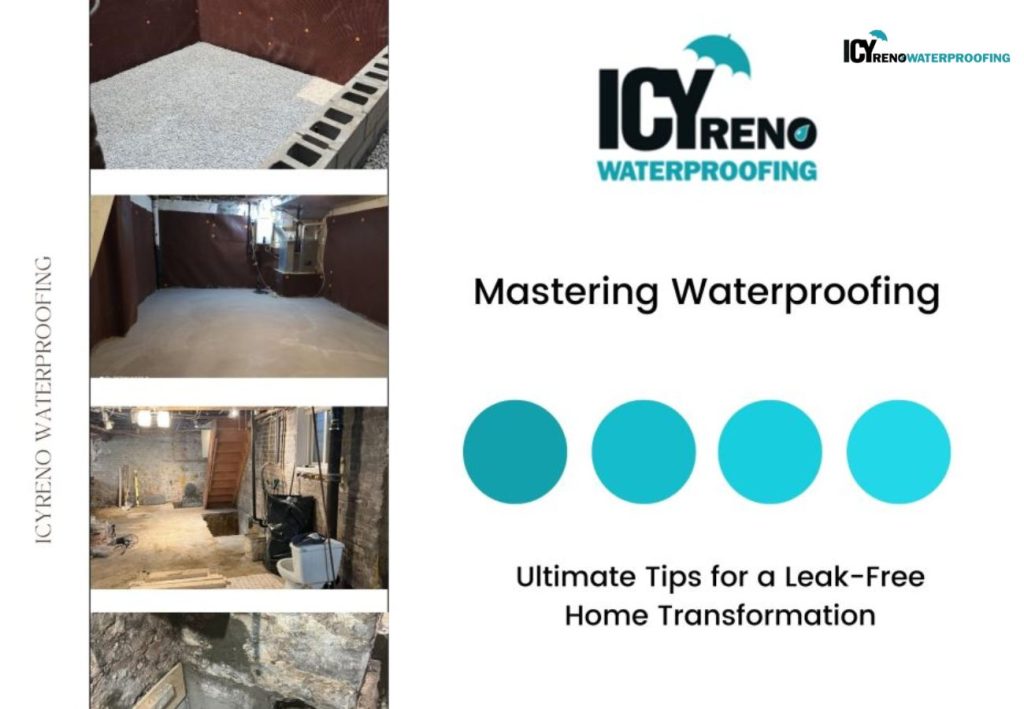Hey there! So, you’re thinking about waterproofing your home yourself? I get it—saving money and tackling home projects can be super rewarding. But before you dive in, let’s chat about what DIY home waterproofing involves and why sometimes it might be better to call in the waterproofing pros like your friends at IcyReno.
Inspecting Your Home for Moisture Issues
First things first, you need to check your home for moisture problems. Grab a flashlight and a moisture meter (you can find these at most hardware stores). Start in the basement, foundation, and exterior walls—these spots are water magnets. Look for cracks, gaps, damp spots, mold, and musty smells.
Outside, check for issues with grading, clogged gutters, and downspouts that aren’t directing water away from your foundation. Take notes or photos of what you find. This inspection might take a bit of time, but trust me, it’s worth it. You need to know where the problems are before you can fix them.

Sealing Cracks and Gaps with Home Moisture Control Products
Once you’ve found those pesky cracks and gaps, it’s time to seal them up. This is crucial because even small cracks can let in a lot of water over time. You’ll need some high-quality crack repair tools and products. Clean the area well before you apply the sealant to make sure it sticks properly.
Hydraulic cement is great for active leaks since it sets quickly and expands as it cures, creating a watertight seal. Epoxy and polyurethane sealants are also good choices because they’re flexible and move with your house without breaking the seal. Make sure you follow the instructions on the product labels for the best results.
Applying Waterproof Coatings
Next up is applying waterproof coatings. These create a barrier that stops water from getting into your home. There are a few types to choose from, like liquid rubber, acrylic, and cementitious coatings. Pick the one that’s right for your needs.
Before you start, clean and dry the surface you’re coating. Get rid of any loose debris, dirt, or old paint. Follow the manufacturer’s instructions for mixing and applying the coating, and make sure you cover the whole area evenly. You might need to apply multiple coats for the best protection, so be patient and let each layer dry completely before adding the next one.
Installing Sump Pumps and Dehumidifiers
To really keep your home dry, think about installing sump pumps and dehumidifiers. Sump pumps get rid of water that collects in your basement or crawl spaces, and dehumidifiers keep the humidity levels down to prevent mold.
When choosing a sump pump, look at the capacity, power source, and whether it has a backup system for power outages. There are pedestal and submersible types—pedestal pumps are easier to maintain, while submersible ones are quieter and more efficient.
Dehumidifiers come in different sizes, so pick one that fits your space. Portable units can be moved around, while whole-house units work with your HVAC system for overall moisture control. Regular maintenance, like cleaning filters and ensuring proper drainage, is key for both sump pumps and dehumidifiers.

Ensuring a Dry and Healthy Home With IcyReno
Okay, so DIY waterproofing can be done, but it’s a big job that takes a lot of time, effort, and know-how. Even small mistakes can lead to big problems down the line. That’s why sometimes it’s best to bring in the experts.
IcyReno specializes in keeping homes safe, dry, and comfy. They’ve got the experience to handle everything from inspections and crack repairs to waterproof coatings and moisture management systems. By trusting the pros, you save time, avoid costly mistakes, and get peace of mind knowing your home is protected from moisture damage. Give them a call to see how they can help you keep your home dry and healthy.
FAQs
What are the first steps in DIY home waterproofing?
The first steps in DIY home waterproofing include thoroughly inspecting your home for potential moisture issues. Identify areas prone to water leakage, such as the basement, foundation, and exterior walls. Look for cracks, gaps, and signs of water seepage to prioritize the areas that need immediate attention.
What types of products are used to seal cracks and gaps in DIY home waterproofing?
High-quality crack repair tools and products, such as hydraulic cement, epoxy, and polyurethane sealants, are used to seal cracks and gaps. These products ensure a strong bond and create a watertight seal, preventing water from seeping into your home and causing damage.
How do you apply waterproof coatings during DIY home waterproofing?
To apply waterproof coatings, first clean and dry the surface to remove any loose debris, dirt, or old paint. Choose the right type of coating, such as liquid rubber, acrylic, or cementitious coatings, and follow the manufacturer’s instructions for mixing and applying. Ensure even coverage and apply multiple coats if necessary, allowing each layer to dry completely.
What is the role of sump pumps and dehumidifiers in home waterproofing?
Sump pumps remove accumulated water from basements and crawl spaces, preventing flooding and water damage. Dehumidifiers maintain optimal humidity levels, reducing the risk of mold growth and improving indoor air quality. Both products are essential in maintaining a dry and healthy home environment.
Why might it be better to hire a professional for home waterproofing?
DIY home waterproofing can be challenging and time-consuming, requiring proper inspection, product selection, and precise application. Minor mistakes can lead to significant issues down the line. Hiring a professional like IcyReno ensures the job is done correctly and efficiently, saving time, avoiding costly mistakes, and providing peace of mind.
